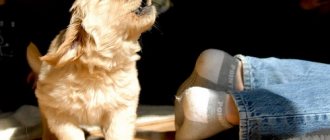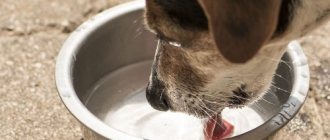Experienced dog breeders know that dogs sometimes suffer from a variety of ailments of viral and infectious origin that can affect many organs of the animal. Sometimes the pet’s behavior changes, which becomes visually noticeable: the dog drifts to the left when walking. Often, such a movement disorder in a dog is caused by vestibular vertigo, when for no external reason the dog loses its balance. Sometimes this condition, when a dog falls on its side when walking, activates profuse drooling, nausea, rapid breathing and increased heart rate. In such situations, experts recommend urgently contacting a veterinary clinic to conduct a full examination of the animal.
What is ataxia in dogs
Loss of coordination in dogs, or ataxia, is characterized by a shaky and uncertain gait, leaning to any side, and refusal to move. This is not an independent disease, but only a consequence of violations.
Characteristic
The resulting pathology is not independent and acts as a symptom of diseases of the central nervous system and/or vestibular apparatus. Most often, damage occurs in the brain and spinal cord.
Despite the possible preservation of muscle strength, the sick animal loses orientation in space and usual mobility. This affects the quality of life and often results in death due to injuries.
Breed predisposition
The disorder can occur in any pet, but some breeds are more vulnerable than others. These include:
- bobtails;
- cocker spaniels;
- Australian Kelpies;
- Border Collie;
- Chinese Crested;
- amstaffs;
- Staffordshire, Scottish, Scotch, Airedale and Jack Russell terriers;
- Sennenhunds;
- Scottish Setters;
- German Shepherds.
Owners of animals at risk should sign up their pets for a DNA test. If you receive a positive result, you should take care of their safety by following preventive recommendations.
Forecast
For vestibular syndrome in dogs, the prognosis largely depends on the cause of the disorder. If the disorder is caused by abuse of ear cleaners or otitis media, the prognosis is positive. Another thing is neoplasms. For primary or secondary tumors, especially in the later stages of development, the veterinarian always gives a very cautious prognosis. With idiopathic vestibular syndrome, it is difficult to give a prognosis. The veterinarian will base it on the severity of the symptoms and the general condition of the animal.
Why the disorder occurs: 10 reasons
Depending on the cause of occurrence, the disorder is divided into congenital and acquired. In the first case, everything is explained by a genetic predisposition: you can find out about its presence by reading detailed information about the health of the parents before purchasing a puppy.
In the second case, pathology occurs for the following reasons:
- Neoplasms
. The most dangerous are malignant tumors that affect brain cells. Benign polyps and cysts affecting nerve endings also cause similar symptoms.
- Ear inflammation
. Internal and otitis media is one of the most common causes, since the organ of hearing is directly related to balance.
- Intoxication
. In addition to poisons, poisoning can be caused by helminth waste products. With an advanced form of helminthiasis, encephalopathy develops, accompanied by pathological changes in brain tissue.
- Ophthalmic diseases
. An unsteady gait occurs with any eye disease that weakens vision.
- Anemia
. A lack of red blood cells results in oxygen starvation and gradual muscle weakening.
- Injuries
. This includes any mechanical damage to the spinal cord and brain.
- Infections
. Gait disturbances are caused by plague, myelitis, toxoplasmosis, encephalitis, cryptococcosis and other diseases affecting brain structures.
- Vitamin B, calcium or glucose deficiency
. These substances are necessary for the normal functioning of the brain, so their deficiency leads to a critical condition.
- Dehydration
. When there is a lack of fluid inside the body, the missing amount is drawn from its own tissues and cells. As a result, the muscles lose their elasticity.
- Vascular diseases of the brain
. This group includes strokes that occur due to bleeding disorders, arterial hypertension, hormonal disorders and sepsis.
Treatment directly depends on the cause, so it is very important not to engage in self-diagnosis and be examined at a veterinary clinic when the first alarming signs appear. The sooner help is provided, the lower the likelihood of complications - and the more favorable the prognosis.
What to do at home
Many owners have a question: “How to help a dog at home?” The answer is clear: strictly follow the doctor’s instructions and do not self-medicate, as it can lead to irreversible consequences. The maximum that can be done is to create a comfortable environment for the dog, provide it with good care and quality feeding.
As the disease progresses and the dog becomes completely helpless, the owner must be prepared for the fact that he will have to care for the pet, remove feces in a timely manner, and perform anti-bedsore massage.
Separation of pathology by type
According to localization, pathology is divided into 6 types. Despite the similar symptoms, each of the varieties has its own characteristic features and occurs for different reasons.
Vestibular
Vestibular ataxia in dogs develops with damage to the brain stem and internal form of otitis media. Sick animals lose orientation in space, and any surface seems inclined. Because of this, they constantly lean forward or to the sides, walk in circles and exhibit unusual lethargy. With sudden movements they experience dizziness and vomiting.
Cerebellar
Cerebellar ataxia in dogs occurs when nerve cells in the cerebellar cortex are lost. Depending on the characteristics of the manifestation, this type is divided into 2 varieties: static and dynamic. In the first case, there is a severe loss of muscle mass, which makes it difficult to maintain immobility. In the second case, coordination is completely lost. This is especially noticeable when moving.
The cerebellum is the part of the brain responsible for muscle tone, balance and coordination. It consists of two layers:
- external, processing information and making decisions;
- internal, transmitting data throughout the body.
If at least one of the layers is damaged, the cerebellum loses its functions.
Sensitive
It is observed with damage to the spinal cord. This type is typical for oncology, inflammation and other pathologies of intervertebral discs. A sick animal cannot bend or straighten its joints. When the form is advanced, the ability to move is completely lost.
Sensory
The rarest variety, manifested by increased symptoms when closing the eyes. Its main symptom is loss of sensation in the limbs, causing the development of partial or complete paralysis. Occurs in case of poisoning, polyneuropathy and spinal cord injuries.
Frontal
Develops when the frontal lobe or temporo-occipital region is affected. Accompanied by a shaky gait with the paws positioned in a straight line and the body tilted back.
Psychogenic
The symptoms of this type differ from organic lesions of the nervous system. The movement of sick animals is very similar to ice skating. They slide their paws, moving along a broken line, cross their limbs or walk without bending their joints.
Treatment of vestibular syndrome
With vestibular syndrome in a dog, two situations are possible. The first is when the cause of the disorder is known (for example, trauma or inflammatory disease). The second is idiopathic vestibular syndrome, when the cause of the lesion is not identified.
In the first case, when the cause is precisely known, the veterinarian prescribes therapy aimed at eliminating it. The main methods of treatment include the use of systemic antibiotics and lavage of the middle ear, surgical removal of tumors, discontinuation of aminoglycosides, etc.
On a note! The main thing with vestibular syndrome is to eliminate the cause that led to its development. Usually this is enough for the dog’s condition to improve, dizziness and other symptoms of the disorder to go away.
In the second case, when a dog is diagnosed with idiopathic vestibular syndrome, it is impossible to select a specific treatment. The use of corticosteroids does not improve the animal's condition. Only supportive treatment (eg, nausea and vomiting) is used.
In approximately 60% of cases, a dog with idiopathic vestibular syndrome improves within 3-5 days, and returns to normal after 2-3 weeks. However, in some animals the head tilt remains even after other signs of the disorder have subsided.
In both cases, regardless of whether the cause of the vestibular disorder is known, supportive therapy is used. It involves various physiotherapeutic procedures that will help the dog’s body recover faster from the disorder.
What symptoms should you be wary of?
The number and intensity of symptoms of ataxia vary from person to person. The greatest number of alarming manifestations is observed in the mixed form of the disease, when not one, but several varieties are diagnosed.
At the puppy's
In the congenital form, the first symptoms can be detected at 4-5 weeks of life. Sick babies are very clumsy. They constantly fall over on their side after a couple of steps and have difficulty getting up on all 4 legs.
If by 4-6 months the puppy still cannot maintain balance and constantly falls, contact your veterinarian. Such clumsiness is normal only in the first months of life.
You should also monitor feeding. If your pet strangely twists its neck and body without getting its muzzle into the bowl, hurry up and schedule an examination.
In an adult dog
Most often, the disease develops in animals older than 6-7 years. It is accompanied by the following symptoms:
- sudden loss of coordination, manifested by body collapse and squatting when turning;
- increasing weakness, decreased activity and loss of appetite;
- hearing impairment and periodic involuntary movements of the eyeballs;
- erratic head rotation and muscle tremors;
- falling out of the blue for no reason;
- problems with climbing stairs or jumping onto vertical surfaces.
If you notice only one of the listed symptoms, do not wait for the condition to worsen and rush to seek help. Timely treatment will help prevent the development of complications.
Symptoms of cerebellar ataxia
The symptoms of cerebellar ataxia are also important to become familiar with, since disturbances in motor coordination can progress over many years. Experts note that in some situations the clinical picture of the disease does not appear for several years. Here is a list of the main symptoms that appear in dogs, regardless of breed and other things:
- nervousness;
- constant trembling;
- inappropriate behavior of the pet;
- lack of coordination;
- strange behavior when walking, because the dog can take uncharacteristically long steps, after each of which it will freeze in confusion;
- the occurrence of panic attacks, the animal in most situations will try to hide somewhere, especially when the owner appears;
- sometimes the dog may even fall while walking, and the frequency of such incidents completely depends on the type of ataxia and the stage of development;
- weakness, which may progress as the disease develops;
- situations in which the pet begins to rotate its head or even eyeballs very quickly, which is a little less common;
- hearing impairment;
- possible fall into a state of lethargic sleep;
- significant decrease in appetite;
- a condition in which the dog constantly strives to tilt its head to one side;
- other changes related to the behavior of pets.
With cerebellar ataxia, as mentioned earlier, the symptoms are much more serious, because the pet may not even recognize its owners, and may also lose control of the body!
Diagnostic methods
Before making a diagnosis, it is important to exclude diseases with similar symptoms. To do this, the following studies are carried out:
- blood and urine tests, including rapid tests for parasites;
- Ultrasound of internal organs;
- examination of the ears for injuries, inflammation and hearing acuity;
- smears for cytology, revealing the presence of pathogenic microorganisms;
- MRI, CT and X-ray, determining the presence of tumors and injuries;
- Romberg test, which evaluates coordination capabilities.
After collecting an anamnesis, examining the four-legged patient and receiving the results of all necessary studies, the veterinarian selects treatment, taking into account the type and cause of the pathology.
Diagnostic measures
The owner is unlikely to be able to personally determine the reason why the dog is moving backwards. Therefore, as soon as you notice the dog’s uncertain movements or trembling of its paws, you need to take the dog to the veterinarian. Of course, doctors do not have any single prescription.
Attention! Only after a comprehensive examination and history collection will an experienced veterinarian be able to determine the root cause of coordination failure.
Among laboratory tests, a general analysis of blood and urine will be in demand, and additional methods of data collection may include X-ray examination, which can make it possible to exclude head injuries and internal secretory otitis media, and MRI, which provides more complete information regarding the presence of tumors in the brain and inflammatory diseases. processes.
Having excluded the main ailments with coinciding symptoms (metabolic disorders, parasitic diseases or diseases of internal organs), the specialist is able to narrow the selection circle, and at the end he can only examine the condition of the external ear canal and eardrum. If, as a result of the examination, a rupture of the eardrum was found, then it is possible to suspect otitis of the middle and inner ear as a factor in the failure of movement coordination.
How is ataxia treated in dogs?
There are no drugs to correct the functions of the cerebellum, so the congenital form cannot be treated. The therapy used is aimed at relieving the causes of the disorder, preventing complications and improving the well-being of the sick pet.
Drug therapy
Infectious diseases are treated with antibiotics and antivirals. All other drugs are used to relieve associated symptoms. The pet may be prescribed:
- analgesics and antispasmodics;
- anti-inflammatory;
- diuretics;
- sedatives;
- immunomodulators.
In case of poisoning by poisons or parasites, detoxification therapy is carried out and anthelmintics are prescribed. Deficiencies, anemia and dehydration are eliminated by reviewing the diet and intravenous injections of glucose solution. Treatment of vascular diseases involves the use of medications that improve the metabolism of nervous tissue and stimulate blood circulation.
In what cases is surgery indicated?
Surgical intervention is provided for neoplasms, injuries and some ophthalmological diseases. Under general anesthesia, the affected tissue is excised from the animal and the consequences of existing damage are eliminated. Additionally, chemotherapy may be required.
Features of life, care and nutrition
Despite the disease, many pets continue to remain active. In this case, you should take care of their safety:
- Avoid living on the street. The patient should live in a spacious room next to the owner.
- Place the bed or house away from potentially dangerous objects: sharp corners and heavy objects.
- Place the feeder and water bowl on stands to prevent accidental tipping.
If there is paralysis, the pet needs a special massage of the paws and back. The appearance of bedsores can be avoided by timely turning the dog from side to side.
The diet should consist of easily digestible food. Make sure your pet gets enough vitamins. If necessary, be sure to include them in your daily menu in the form of ready-made complexes or individual supplements.
How to help your pet
A dog’s swaying while walking is a very dangerous and difficult phenomenon for the animal; for this reason, the owner is obliged to do everything possible to prevent the development of the disease and, with the help of a veterinarian’s testimony, to prevent the development of an irreversible pathology when the dog constantly drags its feet.
The list of main preventive measures in the above version includes:
- Purchasing puppies only from responsible breeders who do not use individuals with hereditary problems for breeding.
- Appropriate treatment of non-contagious and infectious diseases of your pet.
- Use for feeding only the most balanced feed mixtures containing the required amount of B vitamins.
- Compliance with the vaccination schedule.
- Ensuring the animal's constant access to purified drinking water.
- Regularly check your dog's health.
- Contact your veterinarian immediately if there is such a change in your pet’s behavior.
Timely vaccination is an important preventive measure.
In addition, in order to protect your beloved dog from infections, you need to promptly take the animal for a hygienic haircut and perform other mandatory hygiene procedures: cleaning the dogs’ ears and trimming their nails.
There are actually many reasons for an unsteady gait and they are not always safe. Only a visit to a veterinarian will guarantee the diagnosis of the disease in which the dog is moving backwards, and will protect your beloved pet from dire consequences.
Forecasts and possible consequences
The loss of the ability to coordinate one's actions often results in injuries to the paws and fingers. Head tremors that interfere with chewing food can lead to life-threatening exhaustion. In case of complete paralysis and stable deterioration of health, euthanasia is recommended.
A favorable prognosis is typical for acquired vestibular and sensitive pathologies detected at an early stage. If all neurological signs disappear during treatment, the animal is able to live a normal life again.











